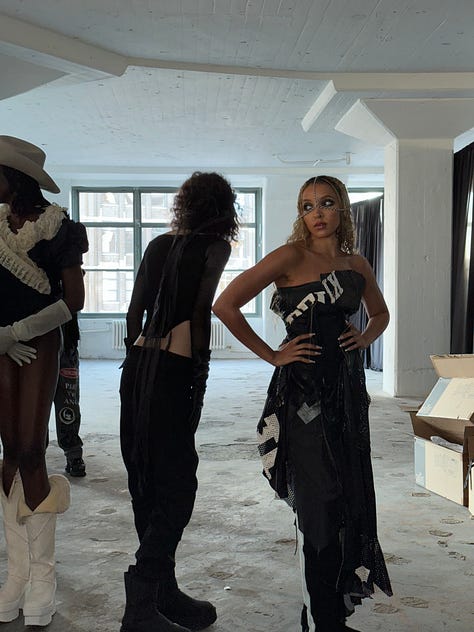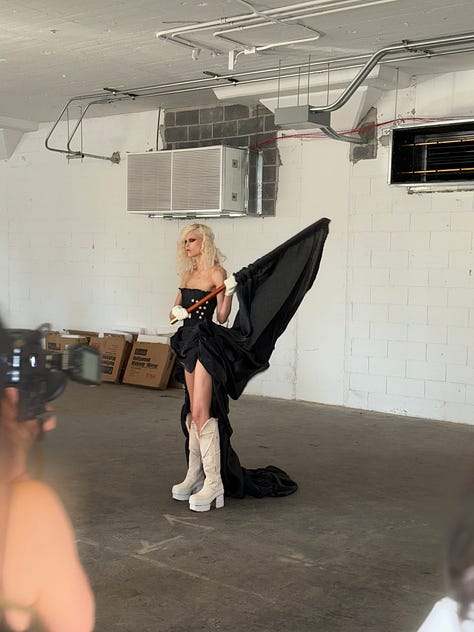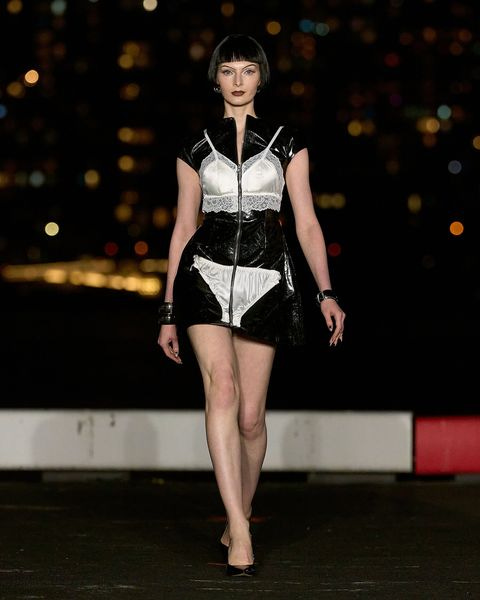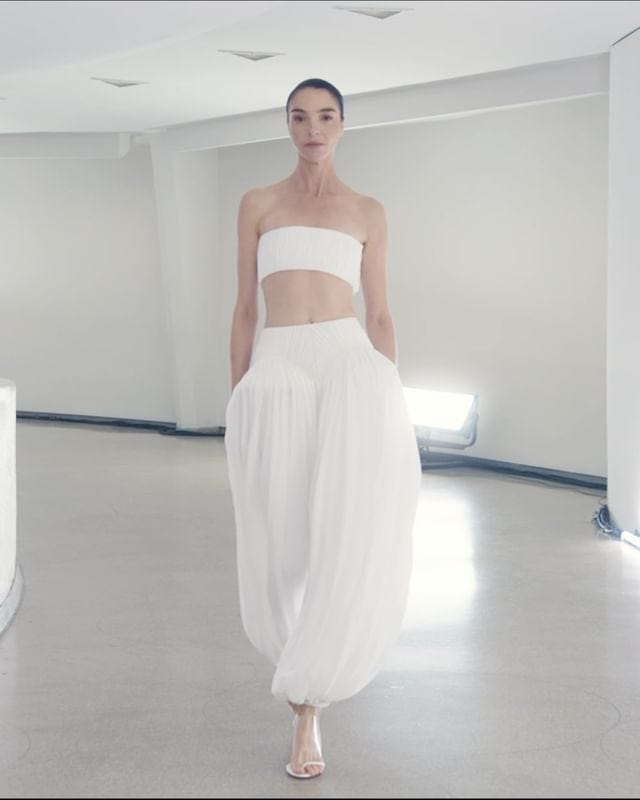The State of Sexuality in Fashion Week
From nearly bare chests to icons of womanhood to an OnlyFans sponsorship, what are our clothes telling us about our relationship with sensuality?
Hello and welcome back to Many Such Cases.
Last week, I had too much fun attending Elena Velez’s New York Fashion Week show documenting her Spring 2025 Ready-to-Wear collection “La Pucelle” on Tuesday, and the after party that followed. The next day, I set off for Miami, where I reported on an in-person dating event hosted by a dating app. That story will go live elsewhere soon.



I don’t know a ton about fashion. I’d like to, but it often feels a bit too opaque, with layers of tradition and history and branding that go beyond my scope. I’m honored that Velez — whom I consider my friend — let’s me get anywhere near her shows at all. But what makes fashion so rich is that it remains accessible in some form, regardless: a background in its themes will help you read a piece of clothing like a text, yes, but the immediate emotions of it are available to us all.
Clothing, moreover, can convey a sense of intimacy that isn’t always as direct in other art forms. It is, after all, worn directly on the body.
For these reasons, we often view fashion and clothing trends as a barometer of our views toward sexuality. This isn’t necessarily always straightforward — as I wrote for Jezebel in February, fashion is full of empty signifiers. We exist in an era where clothing is constantly signaling sex (i.e. the Skims nipple bra) and yet the data shows that people are having less sex. And surely, as I’ve routinely argued, it is perhaps because our culture is so permissive of these more pornified images of sexuality that actual intimacy has declined. I don’t mean to sound like a prude; some of these over-the-top items are fun and have a place. But this sense of contradiction is one of the defining features of our current sexual culture.
Still, high fashion tends to utilize these signifiers in less gauche ways, with some exceptions. This season, there was an abundance of delicate whites, crisp cottons and transparent lace. The themes we associate with this are obvious, centering on purity. In few cases did that appear to be the intended message, however. Both LaQuan Smith and Grace Ling showcased semi-sheer white gowns with cut outs and high slits, accentuating the breasts, stomach and legs.
Other designers took things straight to the bedroom, like Christian Cowan. Cowan’s runway featured models in black burlesque bobs and large bamboo-shaped metal hoops, wearing black leather and latex skirts and dresses with white satin lingerie sewn directly atop. These were looks that appeared intentionally cheap, parody-ish, as if to refer to sexuality in the same way.
But regardless of the clothes, it is likely Velez’s show that introduced the most questions about the relationship between sex and fashion. Her Tuesday show was sponsored in part by several brands, including Ugg and the Foundation for Individual Rights and Expression, but her most provocative sponsor was none other than OnlyFans. OnlyFans has long been pushing to be viewed as a less NSFW company, bringing on athletes, chefs and other influencer types to create non-X-rated content on the platform. To work with a designer such as Velez is only a natural extension of this.
The problem, of course, is that try as they might, OnlyFans is still considered first and foremost an adult platform. That’s also what makes it such an interesting company for Velez to work with. It imbues her collection — which itself had a timeless quality, invoking various historical archetypes and figures — with a hyperreal sense of the now. Who is Joan of Arc in the OnlyFans era? Who is the prom queen, the cowgirl? Who is a woman to be at all?
As Vogue Runway writer Laird Borrelli-Persson wrote, one may have expected a bit more overt sexuality from the show, given its sponsor. She notes that many of the clothes were not modest, and in fact were quite skimpy in length. Even so, my impression of these skimpier items — such as a black tie-front babydoll bodysuit, worn by a model wearing a sash imprinted with “Option Released” carrying a too-heavy crown atop her head and a bouquet of roses — was that they represent sexuality in a nascent form, just coming to terms with itself for the first time. This is precisely the type of sexuality our culture values most, and yet often sees as the biggest threat. It is our most precious yet volatile commodity. The OnlyFans sponsorship only makes that more apparent.
Like the dating app event I attended, Velez’s work and our emotional experience with it are similarly mediated by technology. The only way a young, class conscious designer such as Velez can make her work visible to the world is with help of sponsors like OnlyFans; the only way we can experience love or sex or intimacy or connection is through the help of an app. I commend Velez for integrating the complexities of these relationships in such a nuanced and honest way. Her work represents the negotiations between self, technology and sexuality that define the moment.
Looking to explore what else Fashion Week may have had to offer in the way of a sexual temp check, I asked Internet friend
of for her thoughts on the topic. Bradley is a sharp observer of fashion both high and low, someone with a pristine eye for not only niche runway trends but precisely how they’ve distilled into the everyday. The context and critique she provides here are illuminating:“I think the closest example to Velez’ strategy, at least this season, is Namilia, whose runway tack is to sexually discomfit. I don’t think they make interesting or well-constructed or even blithely satisfactory clothing, and they, too, play to the tenth row by collaborating with major brands (they have a collaboration with Dolls Kill in the year 2024). The ridicule Namilia gets, at least in serious fashion circles, is pretty well-deserved. It’s just not good.
The tricky thing is that Velez IS good. Her FW22 show was v decadent, aggressive, and sexually interesting… clothes that shouldn’t be sexy and yet are, not despite but because of their weirdness. I’d like to see a return to that.
Velez has also been pretty open about her struggles funding her work as a designer, so when it was announced she had so many partners for this show — including OnlyFans — I couldn’t really fault her. Even bigger designers like Brandon Maxwell had a Walmart pop-up shop after the show. It’s getting more and more difficult to run an independent brand, especially in the United States. It’s why Puppets and Puppets moved to London. We just don’t have the resources to support designers (or really anyone in a creative occupation). I think we’ll see more shows conspicuously sponsored by brands, at least in the US, across these coming seasons.
The clothes that both consumers and fashion snobs are really responding to right now tend to both sexy *and* sensual. As for SS25, Alaïa is a wonderful example; same goes for Frederick Anderson, Grace Ling, LaQuan Smith. Those are the shows I can’t stop hearing about. I think people are sick of costume-y, and dare I say, pornified visions of sexuality on the runway, and they want elegant, indulgent, sensual garments again. Mulier’s Alaïa proves you can do that and not be schmaltzy.”
The Alaïa show, it’s worth saying, displays some of the highest quantity of nipples I’ve seen this season. But it is, as Bradley says, elegant, indulgent and sensual — the human element of the breasts works in contrast to the clothing itself. The body and the item inform each other. Frederick Anderson, meanwhile, told ESSENCE of his collection of deep cut dresses, sheer blouses and animal print dresses: “I’m always showing skin and lace is part of my signature. I think what you are feeling is the pulse of the connection to body and earth I wanted to emanate through the collection—a sexuality born from an internal connection to my homeland.”
This sense of dialogue between body, culture and nature through clothing is, I think, what cultivates sensuality. When we lament the flatness of contemporary sexuality, the pornified visions of it all, what we’re experiencing is a lack of discourse. There is nothing being said, only the most obvious, blatant parts of sex being shown. But as artists like Elena Velez, Alaïa and others this last Fashion Week have shown, there are unlimited methods of defying that reality, even as we must engage with it.








